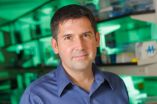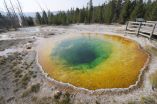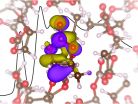(Press-News.org) Not all species may suffer from climate change. A new analysis shows that Dolly Varden, a species of char common in southeast Alaska, adjust their migrations so they can keep feasting on a key food source - salmon eggs - even as shifts in climate altered the timing of salmon spawning.
The resiliency of species to climate change may depend on how well they adapt to climate-driven changes in their food and habitat, such as altered growth of plants they feed on. A mismatch in timing between predators and the availability of prey could cause some species to lose access to food. But others such as Dolly Varden that successfully adjust to shifts in climate and prey offer a climate change story with a happy ending, according to the study published in Freshwater Biology.
Ignoring environmental cues may help this predator
The Dolly Varden's secret appears to be that instead of taking its migration cues from environmental variables such as water temperature or streamflow, the species cues directly off the presence of salmon the Dolly Varden depend on for food, the study found.
"Despite warming temperatures and shifting salmon migrations, Dolly Varden do a great job of following their food," said lead author Chris Sergeant of the National Park Service's Inventory and Monitoring Program in southeast Alaska. "Species that can handle a high degree of variability are the ones that should be most resilient to further changes associated with climate."
Dolly Varden get most of their energy over the course of each year by gorging themselves on salmon eggs, which are abundant in summer and rich in energy thanks to the same fatty acids that make fish healthy for humans. Eggs from any single species of salmon may be available during a narrow spawning window of two to six weeks. The Dolly Varden must follow salmon migrations closely to take full advantage of this annual salmon egg bonanza.
Sticking with salmon to find food
But salmon migrations are shifting as the climate warms. Previous research by the University of Alaska and NOAA Fisheries' Alaska Fisheries Science Center in southeast Alaska's Auke Creek has shown that pink and coho salmon now migrate to their spawning grounds 10 to 17 days earlier while sockeye salmon migrate eight days earlier.
Instead of falling out of synch with salmon, though, seagoing Dolly Varden in Auke Creek have accurately adjusted their annual migrations from the ocean back to freshwater to stick with the salmon. The adjustment has maintained their access to egg meals, according to the new research that includes coauthors from the University of Wyoming and NOAA Fisheries' Northwest Fisheries Science Center.
Researchers rely on long record of fish migration data
The research depended on a wealth of fish data from a weir on Auke Creek maintained primarily since 1980 by NOAA Fisheries' Alaska Fisheries Science Center Auke Bay Labs, supported by collaborations with the University of Alaska Fairbanks and Alaska Department of Fish and Game. From 1997 to 2006 crews counted and measured Dolly Varden migrating from the ocean, past the weir and into Auke Creek, providing an unusual long-term picture of fish migration times.
"We're really indebted to the people who kept that record going for so long," said Eric Ward of the Northwest Fisheries Science Center. "It turns out to be very valuable in understanding how species are responding to the changing climate."
Researchers in the new study used the weir data to examine the relationship between migrations of salmon and Dolly Varden from year to year. They found the timing of Dolly Varden migration more closely related to the presence and timing of the salmon than on environmental variables such as temperature and precipitation that are often seen as driving animal migrations.
In short, the Dolly Varden are shifting their migration to follow their food instead of following temperatures or other environmental cues that, as the climate changes, might otherwise lead them to migrate at a different time than the salmon that provide their most important food.
The researchers cautioned that it's unclear whether other salmon predators could adjust their timing to follow salmon as effectively as Dolly Varden do, apparently by watching salmon passing by or detecting salmon eggs through smell. But the adaptability of Dolly Varden suggests that at least some species may be more resilient to climate-induced changes in migration timing than ecologists might assume.
INFORMATION:
About 15 percent of women in the United States suffer from anxiety disorders and depression during their pregnancies, and many are prescribed antidepressants. However little is known about how early exposure to these medications might affect their offspring as they mature into adults.
The answer to that question is vital, as 5 percent of all babies born in the U.S. - more than 200,000 a year - are exposed to antidepressants during gestation via transmission from their mothers.
Now, a UCLA team has studied early developmental exposure to two different antidepressants, ...
HOUSTON - (Dec. 19, 2014) - An atomically thin material developed at Rice University may lead to the thinnest-ever imaging platform.
Synthetic two-dimensional materials based on metal chalcogenide compounds could be the basis for superthin devices, according to Rice researchers. One such material, molybdenum disulfide, is being widely studied for its light-detecting properties, but copper indium selenide (CIS) also shows extraordinary promise.
Sidong Lei, a graduate student in the Rice lab of materials scientist Pulickel Ajayan, synthesized CIS, a single-layer matrix ...
PROVIDENCE, R.I. [Brown University] -- Neutrophils, a type of white blood cell, are the immune system's all-terrain vehicles. The cells are recruited to fight infections or injury in any tissue or organ in the body despite differences in the cellular and biochemical composition. Researchers from Brown University's School of Engineering and the Department of Surgery in the Warren Alpert Medical School collaborated to devise a new technique for understanding how neutrophils move in these confined spaces.
The technique involves two hydrogel sacks sandwiched together with ...
PHILADELPHIA - (Dec. 19, 2014) - A common polymorphism - a variation in a person's DNA sequence that is found with regularity in the general population - can lead to a chain of events that dictates how a tumor will progress in certain types of cancer, including a form of breast cancer as well as ovarian cancer, according to new research from The Wistar Institute that was published online by the journal Cancer Cell.
The research reveals a more explicit role about the symbiotic relationship humans have with the various bacteria that inhabit our body and their role during ...
(Edmonton) For millions of people around the world, televised medical talk shows have become a daily viewing ritual. Programs such as The Dr. Oz Show and The Doctors have attracted massive followings as charismatic hosts discuss new medical research and therapies while offering viewers their own recommendations for better health. For show producers it's a winning ratings formula, but for viewers eager for a healthier life, the results aren't so clear cut.
"The research supporting any of these recommendations is frequently absent, contradictory or of poor quality," says ...
Women whose loved ones are critical of their weight tend to put on even more pounds, says a new study on the way people's comments affect our health.
Professor Christine Logel from Renison University College at the University of Waterloo led the study, which appears in the December issue of the journal Personal Relationships.
"When we feel bad about our bodies, we often turn to loved ones--families, friends and romantic partners--for support and advice. How they respond can have a bigger effect than we might think," said Professor Logel, who teaches social development ...
WASHINGTON D.C., December 19, 2014 - Researchers at Montana State University and Brandenburg University of Applied Sciences in Germany have created a simple mathematical model based on optical measurements that explains the stunning colors of Yellowstone National Park's hot springs and can visually recreate how they appeared years ago, before decades of tourists contaminated the pools with make-a-wish coins and other detritus.
The model, and stunning pictures of the springs, appear today in the journal Applied Optics, which is published by The Optical Society (OSA).
If ...
Despite showing interest in web or mobile apps to help manage their Type 2 diabetes, only a small number of older adults actually use them, says a new study from the University of Waterloo. Approximately 2.2 million Canadians are living with Type 2 diabetes, 2 million of whom are age 50 or older.
The study, which appears in the online edition of the Journal of Diabetes Science and Technology, found that although more than 90 per cent of research participants owned a computer or had daily Internet access, just 18 per cent used applications on this technology to help manage ...
The lithium-ion batteries that mobilize our electronic devices need to be improved if they are to power electric vehicles or
store electrical energy for the grid. Berkeley Lab researchers looking for a better understanding of liquid electrolyte may have found a pathway forward. A team led by Richard Saykally, a chemist with Berkeley Lab's Chemical Sciences Division, David Prendergast, a theorist with Berkeley Lab's Molecular Foundry, and Steven Harris, a chemist with the Lab's Materials Sciences Division, found surprising results in the first X-ray absorption spectroscopy ...
It's like a scene from a gamer's wildest dreams: 12 high-definition, 55-inch 3D televisions all connected to a computer capable of supporting high-end, graphics-intensive gaming.
On the massive screen, images are controlled by a Wii remote that interacts with a Kinnect-like Bluetooth device (called SmartTrack), while 3D glasses worn by the user create dizzying added dimensions.
But this real-life, computer-powered mega TV is not for gaming. It's for engineering.
Welcome to Brigham Young University's VuePod, a 3D immersive visualization environment run by BYU's Department ...







